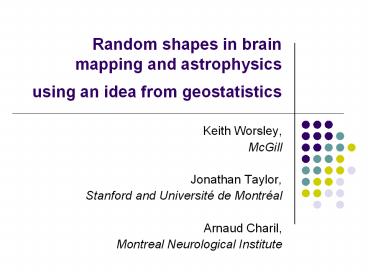Random shapes in brain mapping and astrophysics using an idea from geostatistics - PowerPoint PPT Presentation
Title:
Random shapes in brain mapping and astrophysics using an idea from geostatistics
Description:
Title: Detecting Connectivity between Images: the 'Bubbles' Task in an fMRI Experiment Author: Keith Worsley Last modified by: Keith Worsley Created Date – PowerPoint PPT presentation
Number of Views:121
Avg rating:3.0/5.0
Title: Random shapes in brain mapping and astrophysics using an idea from geostatistics
1
Random shapes in brain mapping and
astrophysicsusing an idea from geostatistics
- Keith Worsley,
- McGill
- Jonathan Taylor,
- Stanford and Université de Montréal
- Arnaud Charil,
- Montreal Neurological Institute
2
(No Transcript)
3
CfA red shift survey, FWHM13.3
100
80
60
"Meat ball"
40
topology
"Bubble"
20
topology
0
Euler Characteristic (EC)
-20
-40
"Sponge"
-60
topology
CfA
-80
Random
Expected
-100
-5
-4
-3
-2
-1
0
1
2
3
4
5
Gaussian threshold
4
Brain imaging Detect sparse regions of
activation Construct a test statistic image
for detecting activation Activated regions test
statistic gt threshold Choose threshold to
control false positive rate to say 0.05 i.e.
P(max test statistic gt threshold)
0.05 Bonferroni???
5
Example test statistic
Z1N(0,1)
Z2N(0,1)
s2
s1
Rejection regions,
Excursion sets,
Threshold t
Z2
Search Region, S
Z1
6
Euler characteristic heuristic
Search Region, S
Excursion sets, Xt
EC 1 7 6 5 2
1 1 0
Observed
Expected
Euler characteristic, EC
Threshold, t
7
Tube(?S,r)
Radius, r
Tube(Rt,r)
Radius, r
Z2
r
Rt
r
?S
Z1
Probability
Area
Radius of Tube, r
Radius of Tube, r
8
Z2N(0,1)
Rejection region Rt
r
Tube(Rt,r)
Z1N(0,1)
t
t-r
Taylors Gaussian Kinematic Formula
9
r
Tube(?S,r)
?S
Steiner-Weyl Volume of Tubes Formula
10
Edge length ?
Lipschitz-Killing curvature of simplices
FWHM/v(4log2)
Lipschitz-Killing curvature of union of simplices
11
Non-isotropic data?
ZN(0,1)
s2
s1
Can we warp the data to isotropy? i.e. multiply
edge lengths by ?? Locally yes, but we may need
extra dimensions. Nash Embedding
Theorem dimensions D D(D1)/2 D2
dimensions 5
12
(No Transcript)
13
Warping to isotropy not needed only warp the
triangles
ZN(0,1)
ZN(0,1)
s2
s1
Edge length ?
Lipschitz-Killing curvature of simplices
FWHM/v(4log2)
Lipschitz-Killing curvature of union of simplices
14
We need independent identically distributed
random fields e.g. residuals from a linear model
Replace coordinates of the simplices in S?RealD
by (Z1,,Zn) / (Z1,,Zn) in Realn
Lipschitz-Killing curvature of simplices
Unbiased!
Lipschitz-Killing curvature of union of simplices
Unbiased!
15
MS lesions and cortical thickness
- Idea MS lesions interrupt neuronal signals,
causing thinning in down-stream cortex - Data n 425 mild MS patients
- Lesion density, smoothed 10mm
- Cortical thickness, smoothed 20mm
- Find connectivity i.e. find voxels in 3D, nodes
in 2D with high - correlation(lesion density, cortical thickness)
- Look for high negative correlations
16
n425 subjects, correlation -0.568
Average cortical thickness
Average lesion volume
17
Thresholding? Cross correlation random field
- Correlation between 2 fields at 2 different
locations, searched over all pairs of locations - one in R (D dimensions), one in S (E dimensions)
- sample size n
- MS lesion data P0.05, c0.325, T7.07
Cao Worsley, Annals of Applied Probability
(1999)
18
Normalization
- LDlesion density, CTcortical thickness
- Simple correlation
- Cor( LD, CT )
- Subtracting global mean thickness
- Cor( LD, CT avsurf(CT) )
- And removing overall lesion effect
- Cor( LD avWM(LD), CT avsurf(CT) )
19
Histogram
threshold
threshold
Conditional histogram scaled to same max at
each distance
threshold
threshold






























